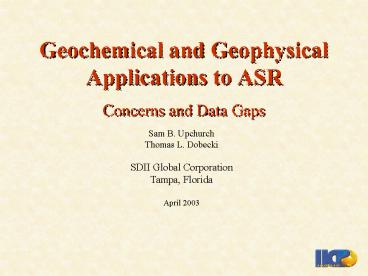Geochemical and Geophysical Applications to ASR PowerPoint PPT Presentation
1 / 19
Title: Geochemical and Geophysical Applications to ASR
1
Geochemical and Geophysical Applications to ASR
- Concerns and Data Gaps
Sam B. Upchurch Thomas L. Dobecki SDII Global
Corporation Tampa, Florida April 2003
2
Introduction
- ASR is an exciting and effective means of
managing water for storage and later use - There are several issues that, in our opinion,
have not been adequately addressed - These deal with
- Characterization of the injectate bubble,
- Monitoring designs, and
- Geochemical reactions operative in the aquifer
3
Historic Concerns
- Potentials for drift of injectate away from
control of ASR system - Increasing concentrations of gross alpha
(polonium-210), arsenic, and other constituents
in injectate - Potential plugging and loss of storage capacity
- Microbial activity
4
Geologic Controls
5
Example
- Connected fractures and caverns are usually
coated with colloidal and microcrystalline iron
sulfide, ferric hydroxide, and clay - Dissolution releases arsenic, polonium, and other
constituents
6
Needs
- Predict porosity type and distribution
- Predict plume movement
- Monitor for accurate physical behavior of plume
- Avoid or correct for adverse chemical conditions
Solutions involve early understanding of geologic
controls and a well-designed monitoring plan
7
Injectate Bubble Characterization
- The configuration of the mass of injectate in the
aquifer has been the subject of much debate - Unfortunately, little has been done to resolve
the shapes of injectate masses (geometries are
probably site specific) - The shape of the injectate mass (the bubble)
has significant implications as to fluid behavior
(chemistry and amount recovered) and monitoring
(detection, safety)
8
The Ideal Bubble
- The ideal bubble is more or less a flattened
sphere - The concept requires that several conditions
exist in the injection zone
9
The Ideal Bubble (cont.)
- Assumes more-or-less isotropic materials
- Permeability
- KH KV rough sphere
- KH lt KV squashed sphere
- Injectate fills intergranular porosity, so
waterrock interface surface area is - Very high and
- Chemical reactions should progress moderately
because of high grain surface areas - Residual fluids are probable
10
Monitoring an Ideal Bubble
- Monitoring is simple
- Leads to radial plan
- If ideal bubble is present, extent is the only
issue
11
Ideal Bubble Movement
- Ground-water movement can cause bubble to shift
down gradient
12
Ideal Bubble Movement
- Radial design may miss
- Extent and/or
- Orientation of plume
13
Bubble Buoyancy
- Buoyancy issues cause bubble to migrate out of
injection zone - Monitoring designs should account for such events
14
The Ganglion Model
- Injectate moves along bedding planes, caverns,
fractures - System is anisotropic
- KH gtgt KV,
- KH1 gtgt KHH2
15
Ganglion Model
- Surface area in contact with injectate is
relatively low - Chemical reactions inhibited unless colloids
present
- Monitoring difficult to predict
- Need to guide monitoring plan
16
Glangion Movement
- Compounds monitoring difficulty
- May exaggerate extent of plume
17
Data Gaps and Concerns
- Traditional monitoring may limit understanding
and detection of injectate - Prior knowledge of isotropy and porosity
distribution important to monitoring design - Porosity distribution important to controlling
reaction rates and access to constituents of
concern
18
Suggested Approaches
- Accurate photolineament studies with deep
geophysical ground-truthing (seismic profiling) - Video and geophysical borehole logs to
characterize fractures, porosity types, and
fracture fill (if possible) - Modeling (Monte Carlo simulations of fractures,
flow modeling, geochemical modeling) of
worst-case scenarios for transport prior to
monitoring design
19
Suggested Approaches (cont.)
- Cross-hole geophysics (seismic, electrical
tomography) for block-of-rock characterization - Surface geophysics (transient electromagnetic
sounding, controlled source audio magnetotelluric
profiling, etc.) to develop a flexible monitoring
program that can move with the bubble

